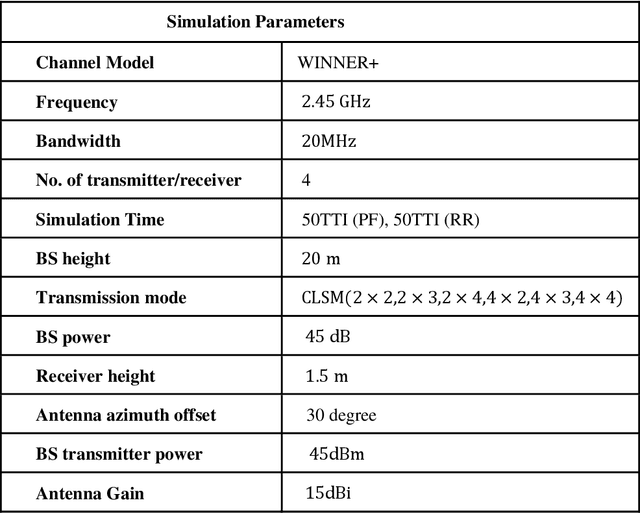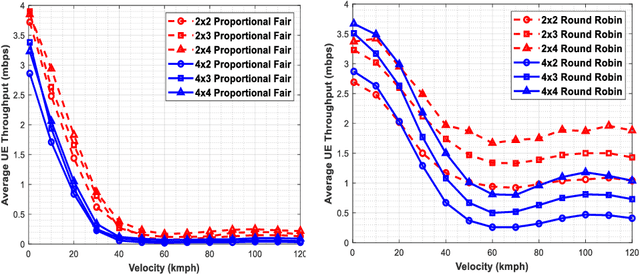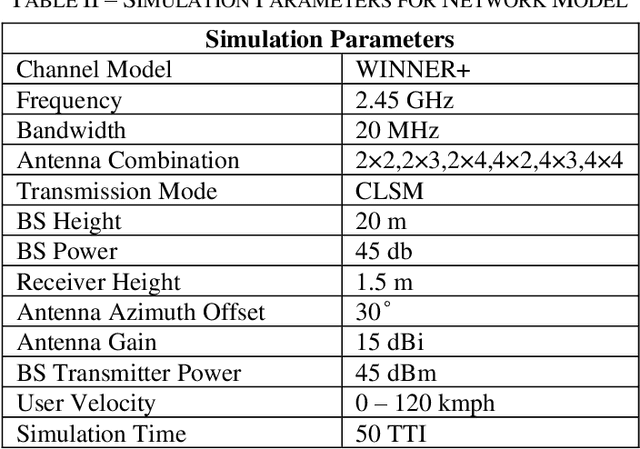Md. Asif Ishrak Sarder
Downlink Performance Enhancement of High Velocity Users in 5G Networks by Configuring Antenna System
Aug 10, 2021



Abstract:A limitation of bandwidth in the wireless network and the exponential rise in the high data rate requirement prompted the development of Massive Multiple-Input-Multiple-Output (MIMO) technique in 5G. Using this method the ever rising data rate can be met with the increment of the number of antennas. This comes at the price of energy consumption of higher amount, complex network setups and maintenance. Moreover a high-velocity user experiences unpredictable fluctuations in the channel condition that deteriorates the downlink performance. Therefore a proper number of antenna selection is of paramount importance. This issue has been addressed using different categories of algorithms but only for static users. In this study we proffer to implement antenna diversity in closed loop spatial multiplexing MIMO transmission scheme by operating more number of reception antennas than the number of transmission antennas for ameliorating the downlink performance of high-velocity users in case of single user MIMO technology. In general our results can be interpreted for large scale antenna systems like Massive MIMO even though a 4x4 MIMO system has been executed to carry out this study here. Additionally it shows great prospects for solving practical life problems like low data rate and call drops during handover to be experienced by cellular users traveling by high-speed transportation systems like Dhaka Metro Rail. The cell edge users are anticipated to get benefits from this method in case of SU-MIMO technology. The proposed method is expected to be easily implemented in the existing network structures with nominal difficulties.
Configuring Antenna System to Enhance the Downlink Performance of High Velocity Users in 5G MU-MIMO Networks
Aug 05, 2021
Abstract:An exponential increase in the data rate demand prompted several technical innovations. Multi User Multiple Input Multiple Output (MU-MIMO) is one of the most promising schemes. This has been evolved into Massive MIMO technology in 5G to further stretch the network throughput. Massive MIMO tackles the rising data rate with the increase in the number of antenna. This comes at the price of a higher energy consumption. Moreover the high velocity users in MU-MIMO scheme experiences a frequent unpredictable change in the channel condition that degrade its downlink performance. Therefore a proper number of antenna selection is of paramount importance. This issue has been addressed using machine learning techniques and Channel State Information (CSI) but only for static users. In this study we propose to introduce antenna diversity in spatial multiplexing MU-MIMO transmission scheme by operating more number of reception antenna compare to the number of transmission antenna. The diversity improves the downlink performance of high velocity users. In general our results can be interpreted for large scale antenna systems like Massive MIMO. The proposed method can be easily implemented in the existing network architectures with minimal complexity. Also it has the potential for solving real-life problems like call drops and low data rate to be experienced by cellular users traveling through high-speed transportation systems like Dhaka MRT project
Impact of Receiver Antenna Polarization and Resource Scheduler on the Downlink Performance of High Velocity Users in 5G Millimeter Wave Small Cell Technology
Aug 05, 2021
Abstract:With the occupancy of the existing frequency spectrum the demands of the skyrocketing data traffic paved the path for 5G millimeter Wave (mmWave) technology. The wide frequency spectrum and high directivity can elevate the mean data rate. This performance gain comes at the cost of a higher pathloss which limits the use of mmWave technology to small cells. Also at such high frequencies the multipath components and blockages appear as persistent barriers leading to alteration of antenna polarization, affecting resource scheduler performance and throughput degradation. The impact of these barriers for high velocity user equipments (UEs) in mmWave network is still left to be studied. Using closed loop spatial multiplexing transmission scheme this study analyses the effect of receiver antenna polarization and types of resource scheduler used in base station on the downlink performance of mobile users (0-120kmph) in the mmWave small cell network. Thorough investigation has been conducted to infer which antenna combination should be advantageous under different scheduling algorithms for high mobility UEs. Our results indicate that the scheduler performance is complimented by the receiver antenna polarization, and by appropriate selection a better downlink performance can be sustained. Also reception under linear polarization performs better over circular polarization for high velocity UEs.
 Add to Chrome
Add to Chrome Add to Firefox
Add to Firefox Add to Edge
Add to Edge